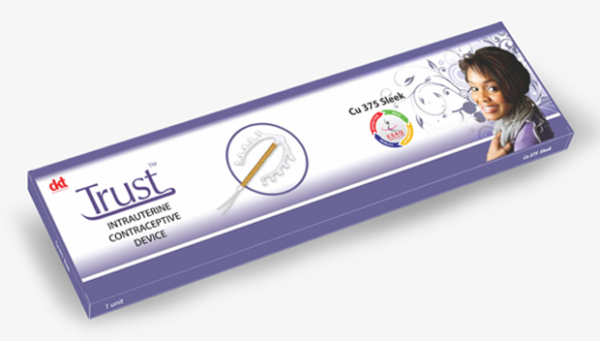Product Description

About SLEEK
Intrauterine devices are the most widely used reversible contraceptives in the world. One of the commonly used copper bearing IUD is the Inara Cu 375 Sleek. A key feature of the Inara IUD models is the ease of insertion and minimum training needs for the service provider.
NB:
- Learn how to examine yourself if the IUD is safely placed after every menstrual cycle (Clinics will instruct you).
- Know that the IUD shall not prevent the transmission of sexually transmitted diseases. Hygiene is important to prevent various bacterial infections.
- If you still do not feel comfortable within three months after inserting IUD go back to the clinic to change the contraception method. Your health and your freedom are very important.
- Some women get more negative impacts on the use of IUDs. Visit a doctor immediately for further advice.
- Inara comes ready for insertion in an insertion tube, therefore less number of steps while inserting than other IUD’s
- Nylon Suture is softer and hence is more comfortable for the couple
- Superior Film pouch keeps the copper parts bright
- Geometric design of Inara’s frame ensures lower expulsion rate
- Geometrical structure and insertion method lowers the probability of accidental perforation of fundus
- Printed insertion tube adds convenience and accuracy for providers
- Inara Cu 375 Sleek offers long term protection upto 5 years (5 years for Cu 375 and 3 years for Cu 250)
- Shorter length of Inara Cu 375 Sleek allows usage by women with smaller uterus
- Small length also provides more comfort for user.
- The shape of the IUD makes the steps of insertion and removal even less.
- Offers long term protection from birth control up to five (5) years.
- The shape of the IUD reduces the likelihood of hurting cervical wall on insertion.
- For most women using the IUD, it has no negative outcomes .Most of them become accustomed to IUDs in a short while .Give it time, your body can take a few months before you get used to the IUD.
- Drops of blood when on menstruation (spotting).
- The quantity of blood during menstruation increases (For users of pawing grad).
- Abdominal pain and backaches.
- “IUDs hurts too much when inserting”No. It’s not true that every woman gets pain on the insertion of the IUD.Most women say that they get so much pain similar to that of menstruation time for a few seconds when inserting the IUD. Although there is a very small percentage of women who claim to get pain during the insertion. It’s important to know bodies vary and every woman may or not get pain depending on their genetic makeup.”IUD causes cervical cancer”It is not true that IUDs causes cervical Cancer. The World Health Organization together with the Ministry of Health have confirmed that the IUDs are safe.”IUDs causes Sterility”Not true that IUDs leads to infertility. IUDs are used numerously because they do not contain hormones(except a few which contain hormones). This means that when you remove the IUD you gain the ability to get pregnant much more quickly than using other forms of contraception.
1. Does the IUD cause pelvic inflammatory disease (PID)?
By itself, the IUD does not cause Pelvic Inflammatory Diseases (PID). STDs like Gonorrhoea and chlamydia are the primary direct causes of PID. This does not happen often. When it does, it is most likely to occur in the first 20 days after the insertion.
2 Can young women and older women use IUDs?
Yes. There is no age limit. It can be removed after menopause has occurred usually within 12 months after the last menstruation.
3. If a current IUD user has a sexually transmitted infection (STI) or has become at very high individual risk of becoming infected with an STI, should her IUD be removed?
No. If a woman catches STI after her IUD insertion, she is not especially at risk of developing Pelvic Inflammatory Diseases because of the Intrauterine Device. She can continue to use the IUD while she is being treated.
4. Does the IUD make a woman infertile?
No. A woman can become pregnant ant time after the IUD is removed as quickly as a woman who has never used an IUD before, although fertility decreases as women get older.
5. Can a woman who has never had a baby use an IUD?
Yes. They can.
6. Can the IUD travel from the woman’s uterus to other parts of her body, such as her heart or her brain?
The IUD never travels to the heart, brain, or any other part of the body outside the abdomen, hilarious.
7. Should a woman have a “rest period” after using her IUD for several years or after the IUD reaches its recommended time for removal?
No. It is not necessary, and it could be harmful. Removing the old IUD and immediately inserting a new IUD poses less risk of infection than 2 separate procedures.
8. Should antibiotics be routinely given before IUD insertion?
No, usually not. Antibiotics may be considered, however, in areas where STIs are common and STI screening is limited.
9. Can IUD be inserted only during a woman’s monthly bleeding?
No. For a woman having menstrual cycles, an IUD can be inserted at any time during her menstrual cycle if it is reasonably certain that she isn’t pregnant. Inserting the IUD during her monthly bleeding may be a good time because she is not likely to be pregnant, and insertion may be easier. It is not as easy, but not as easy as you think unless it’s done by a medical professional.
10. Do IUDs increase the risk of ectopic pregnancy?
No. On the contrary, it reduces the risk of ectopic pregnancy are rare among IUD users.

